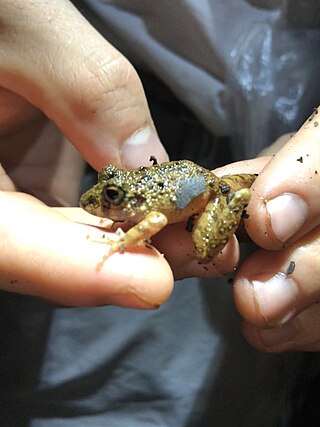
Oreobates is a genus of frogs in the family Strabomantidae. Most species were formerly in the genus Ischnocnema, but were moved to this revalidated genus following a 2006 revision. Its sister taxon is Lynchius.
The multi-coloured tree frog or multi-coloured frog is a species of frog in the subfamily Pelodryadinae. It is endemic to West Papua, Indonesia. Its natural habitats are subtropical or tropical moist lowland forests, subtropical or tropical moist montane forests, swamps, and freshwater marshes. It is threatened by habitat loss.

The Treasury Island tree frog is a species of frog in the subfamily Pelodryadinae. It is found in New Guinea and the Solomon Islands. Its natural habitats are subtropical or tropical moist lowland forests, subtropical or tropical moist montane forests, swamps, freshwater marshes, intermittent freshwater marshes, rural gardens, heavily degraded former forests, and canals and ditches. It is threatened by habitat loss.
The pine forest stream frog is a species of frog in the family Hylidae found in Guatemala and Mexico. Its natural habitats are subtropical or tropical dry forests, rivers, and heavily degraded former forest. It is threatened by habitat loss.
Oreobates cruralis, also known as the La Paz robber frog, is a species of frog in the family Strabomantidae. It is found in Bolivia, Peru, and possibly Brazil. Its natural habitats are subtropical or tropical moist lowland forest, subtropical or tropical moist montane forest, plantations, rural gardens, and heavily degraded former forest.
Oreobates discoidalis, also known as the Tucuman robber frog, is a species of frog in the family Strabomantidae. It is found on the eastern flanks of the Andes in northern Argentina and Bolivia. Its natural habitat is subtropical or tropical moist montane forest. It is threatened by habitat loss.
Oreobates heterodactylus, also known as the Caceres robber frog, is a species of frog in the family Strabomantidae. It is known from the semi-deciduous forest of the Precambrian Brazilian shield of western Brazil and eastern Bolivia. It also inhabits the border areas of the Cerrado savanna and the Pantanal wetlands.
Oreobates lundbergi is a species of frogs in the family Strabomantidae. It is endemic to central Peru and is known from the Amazonian slopes of the Cordillera Oriental in the Paucartambo District, Pasco.
Oreobates madidi is a species of frog in the family Strabomantidae. It is endemic to Bolivia. Its natural habitat is subtropical or tropical moist montane forest.
Pristimantis tubernasus is a species of frog in the family Strabomantidae.
Pristimantis turumiquirensis is a species of frog in the family Strabomantidae. It is endemic to Venezuela. Its natural habitats are tropical moist montane forests and caves. It is threatened by habitat loss.
Oreobates zongoensis is a species of frog in the family Strabomantidae. It is endemic to Bolivia from Zongo Valley, in Pedro Domingo Murillo Province.
Oreobates choristolemma is a species of frog in the family Strabomantidae. It is endemic to Bolivia where it is known from its type locality, Serranía de Bella Vista in the Caranavi Province as well as from Sud Yungas Province and from Chapare Province in the Cochabamba Department.
Ischnocnema sanctaecrucis is a species of frog in the family Strabomantidae. It is endemic to Bolivia where it is known from the Santa Cruz and Cochabamba Departments. It is an uncommon, terrestrial frog inhabiting the Yungas forest ; it tolerates disturbed habitats. It has been found under rocks; males have been observed perching on small secondary vegetation. It is not considered threatened by the IUCN. Its range includes the Carrasco and Amboró National Parks.
Oreobates sanderi is a species of frog in the family Strabomantidae. It is found in north-western Bolivia and nearby south-eastern Peru. It is not considered threatened by the IUCN.
Lynchius simmonsi, also known as Simmons' big-headed frog, is a frog species in the family Strabomantidae. It is endemic to southern Ecuador where it is known from the type locality in the Cordillera del Cóndor, Morona-Santiago Province as well as from the adjacent Zamora-Chinchipe Province. Its natural habitat is subtropical old-growth forest. The type series was collected by day on the forest floor. The area was mined during the Cenepa War in 1995, and has consequently seen little human activity, although this may change through a proposed road.
Oreobates pereger, also known as the Ayacucho Andes frog, is a species of frog in the family Strabomantidae. It is endemic to Peru where it is known from the eastern slopes of the Cordillera Oriental and Cordillera Vilcabamba mountain ranges.
Amnirana fonensis is a species of frog in the family Ranidae. It is endemic to Simandou, Guinea.
Oreobates ayacucho is a species of frogs in the family Strabomantidae. It is endemic to Peru and known from a few localities in the Ayacucho Region in the Peruvian Andes. The species is only known from 11 specimens.

Oreobates amarakaeri, also known as Amarakaeri's big-headed frog is a species of frog in the family Strabomantidae, which is endemic to a small region of south-eastern Peru, in the Manú District, and parts of the Puno Region. The frog was first discovered near the Rio Nusinuscato and Rio Mabe rivers in the Andean foothills of the Amarakaeri Communal Reserve, which are tributaries of the Rio Araza. Since then the species has also been found at the Manú Learning Centre and near Bahuaja Sonene National Park, but weren't fully confirmed to be there until 2019 when four specimens were collected at those localities. At the Manú Learning Centre the frog is known to occur mainly in low disturbance and primary forest habitat, but can also be found near streams in more disturbed areas.



